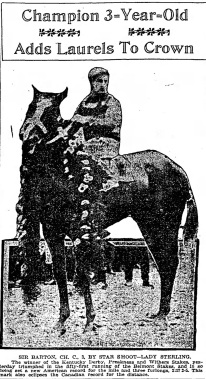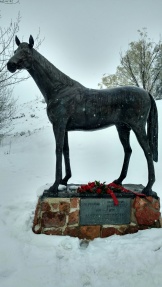America’s latest Triple Crown winner, American Pharoah, ended his racing career with a bang two years ago, winning the Breeder’s Cup Classic in 2:00.07, easily a track record time. California Chrome, another fan favorite and winner of two-thirds of the Triple Crown, went to Gulfstream Park and faced Arrogate again; Chrome finished far back of the big grey colt that bested him in the Breeder’s Cup Classic mere weeks prior. Unlike Pharoah, Chrome’s last race was not a fitting end to the stellar career that included wins in the Dubai World Cup, the Kentucky Derby, the Preakness, and more.
When top horses end their careers with clunkers, hindsight says that the connections should have stopped when they were ahead. How can they allow this horse to go out and tarnish their careers with lackluster starts? The irony is, that any owner or trainer or jockey cannot know that this last start should have been the last start. We’d all like our favorites to go out on top, but rarely do they get to do that.
Man o’ War did, exiting the match race in October 1920 with his stellar reputation intact. The film of his long, twenty-eight-foot stride played across movie houses across the country. Sam Riddle showed him off both on film and in person before sending his prized immortal horse off to stud, satisfied that they had accomplished all that they could with their incomparable colt. The horse that finished second to him in that very same race, Sir Barton, did not fare as well.
Many times as I have researched Sir Barton and his career, I have seen writers say that the match race was the last race for the first Triple Crown winner as it was for his rival. It was not, however; Sir Barton would start three more times before year’s end. The first was ninety-seven years ago, in the Laurel Handicap.
Carrying 125 pounds for this race, Sir Barton strode out onto the Laurel track for this one-mile race. He faced a field of five others, all horses he had seen in one capacity or another, usually when he beat them to the wire. The Laurel Handicap should have been a cakewalk for him, especially given the caliber of performance he had turned in when he won the Merchants and Citizens Handicap in late August. Instead, under a new-to-him jockey, Jack O’Brien, Sir Barton showed little of what had made him so great mere weeks earlier. After a lackluster warm-up, Sir Barton broke well enough, settling into third behind the front-runners. When it came time to make his move and challenge for the lead, O’Brien could not get his mount to respond. They barely held off a surging Sennings Park to finish third in a race with a brisk, but not sizzling pace.
Sir Barton would start two more times, both at Pimlico; he did not win either start, but he was in the money for all of them. The only horse seen fit to challenge Man o’ War was game enough to stay in it, but he didn’t seem to have enough left in his tank — or heart — to be the stellar racehorse that he had been so many times before. Following him throughout this was the towering shadow of his rival, always coloring the prose whenever his name came up in the papers of the day.
Like Chrome and so many others, those last starts did fit the career of the horse that paved the way for Secretariat and American Pharoah, a fitting testament to the uncertainty that is the sport of racing.


 He was always destined to be a champion.
He was always destined to be a champion. In 1919, a colt named Sir Barton dazzled everyone with wins in the Kentucky Derby, the Preakness Stakes, and the Belmont Stakes. This trio of victories changed the sport of horse racing in the United States forever, evolving into the Triple Crown, one of horse racing’s most elite accomplishments.
In 1919, a colt named Sir Barton dazzled everyone with wins in the Kentucky Derby, the Preakness Stakes, and the Belmont Stakes. This trio of victories changed the sport of horse racing in the United States forever, evolving into the Triple Crown, one of horse racing’s most elite accomplishments. Here on the Sir Barton Project, I will count down to the release of Sir Barton and the Making of the Triple Crown with a weekly series of blog posts. Each month, I will profile a book on horse racing and its author, covering a variety of the sport’s iconic personalities. You will find more on Sir Barton and his era, posts that preview what you will find in the book. As a long-time horse racing fan, I will also share my own memories of the sport I love. As we await the 2019 Triple Crown season, please join me here each week in this run-up to the 100th anniversary of Sir Barton’s accomplishment.
Here on the Sir Barton Project, I will count down to the release of Sir Barton and the Making of the Triple Crown with a weekly series of blog posts. Each month, I will profile a book on horse racing and its author, covering a variety of the sport’s iconic personalities. You will find more on Sir Barton and his era, posts that preview what you will find in the book. As a long-time horse racing fan, I will also share my own memories of the sport I love. As we await the 2019 Triple Crown season, please join me here each week in this run-up to the 100th anniversary of Sir Barton’s accomplishment. Ninety-nine years ago, a chestnut colt with a wide white blaze whipped across the finish line at Belmont Park, followed by only two others. Johnny Loftus might have waved his whip in celebration as his mount galloped out, finally trotting over to the judge’s stand to raucous waves of applause from the crowd of 25,000 straining to see the new champion. As Sir Barton received pats of congrats, as Commander Ross stood in the winner’s circle to receive the Belmont’s silver platter, horse racing was forever changed.
Ninety-nine years ago, a chestnut colt with a wide white blaze whipped across the finish line at Belmont Park, followed by only two others. Johnny Loftus might have waved his whip in celebration as his mount galloped out, finally trotting over to the judge’s stand to raucous waves of applause from the crowd of 25,000 straining to see the new champion. As Sir Barton received pats of congrats, as Commander Ross stood in the winner’s circle to receive the Belmont’s silver platter, horse racing was forever changed. One hundred and two years ago, Lady Sterling dropped to the straw of the foaling stall she had been laboring in and, about two in the morning, delivered a beautiful chestnut colt, one of about a hundred born at Hamburg Place that year. The colt had a wide blaze that started high on his forehead, just under his ears, and cascaded down his lovely face, veering off over his left nostril. Half-brother to Sir Martin, the best two-year-old of 1908, the colt that would become Sir Barton was the son of Star Shoot, a descendant of an English Triple Crown winner, and Lady Sterling, a daughter of Hanover, 1887 Belmont Stakes winner. He was royally bred and, as he grew, his potential glowed.
One hundred and two years ago, Lady Sterling dropped to the straw of the foaling stall she had been laboring in and, about two in the morning, delivered a beautiful chestnut colt, one of about a hundred born at Hamburg Place that year. The colt had a wide blaze that started high on his forehead, just under his ears, and cascaded down his lovely face, veering off over his left nostril. Half-brother to Sir Martin, the best two-year-old of 1908, the colt that would become Sir Barton was the son of Star Shoot, a descendant of an English Triple Crown winner, and Lady Sterling, a daughter of Hanover, 1887 Belmont Stakes winner. He was royally bred and, as he grew, his potential glowed.